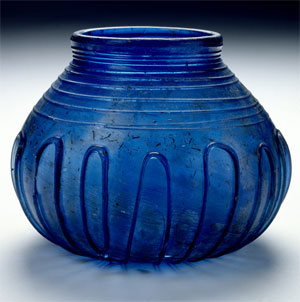
This early seventh-century Anglo-Saxon bowl, probably made in Kent, was discovered in 1847 in Cuddesdon, Oxfordshire. It was found in the grave of an Anglo-Saxon of noble rank, during alterations to the Bishop of Oxford’s palace. The bowl subsequently went missing and was re-discovered in 1971 in a house in Leicestershire, where it was being used as flower vase.
Remains of Anglo-Saxon glass-making furnaces have been found in several areas, notably at York, Glastonbury and Kent. Anglo-Saxon glass making was directly influenced by Roman practices, but the results were generally less refined. A great deal of Anglo-saxon glass was made by melting down broken Roman glass and re-working it.
Making glass from raw materials was more difficult. A silicate (generally sand) and an alkali (generally ash) were mixed and heated together in an oven for several days. It was then broken up, put into a crucible and melted in a furnace to produce glass, which was then blown into a variety of shapes. When made in this form, the glass was clear or slightly tinged. To make coloured glass it was necessary to add a variety of minerals.
The bowl’s dark blue colour was created by adding copper to the molten glass. Around the upper part of the bowl is a thin applied trail of glass, arranged in ten tight spirals. The lower part of the bowl is decorated with thirteen vertical loops. These trails were formed by applying molten glass to the outer surface.
Click to enlarge

Anglo-Saxon glass bowl from Cuddesdon, Oxfordshire (AN1980.269)
This squat dark-blue jar or bowl was probably a drinking cup. The grave in which it was found contained another similar blue bowl, a bronze bucket and an inlaid bronze plaque. A great deal of our information about Anglo-Saxon England comes from artefacts found in graves. (Cremation was also practiced at this time, but graves containing cremated bone (in specially made urns) are usually less well provided with objects). These grave-goods were believed to accompany the dead into the afterlife. In Anglo-Saxon burials the body was normally clothed and provided with ornaments, weapons or vessels appropriate to its gender and status. Drinking vessels and miniature buckets held food and drink for the sustenance of the deceased. Such burials were a pagan practice and gradually died out once the Anglo-Saxons had been converted to Christianity.
The bowl is on display in the ‘England 400-1600’ gallery on the second floor.
Further Information
'Anglo-Saxon remains', in L. F. Salzman, ed., A history of the county of Oxford: Volume 1 (London: Victoria County
History, 1939), 346-372. (Available online from British History Online). See page 352.
Akerman, J.Y., Remains of Pagan Saxondom, (London: J.R. Smith, 1855). (Available online from the Internet Archive). See page 11
Find out more about:
- British Anglo-Saxon Collections at the Ashmolean Museum
- Cuddesdon on the Ashmolean Museum's Oxfordshire's Historic Archives website.
- British Collections Online - searchable database of the collection
Arthur MacGregor
January 2012